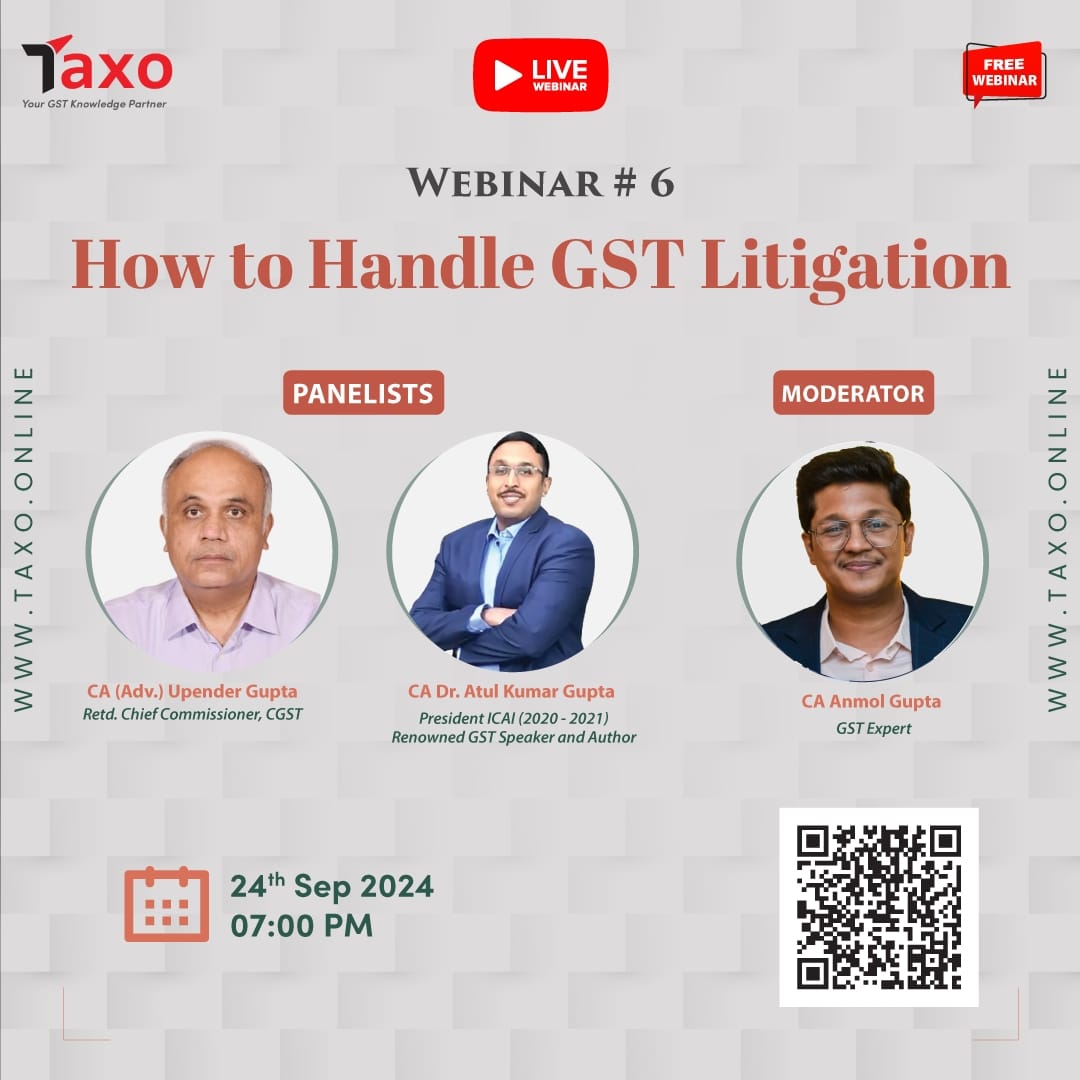Where the building was constructed for the purpose of letting out and tax chain is not broken, the restriction under Section 17(5)(d) is not applicable.
Facts: In this case, the Petitioner is engaged in carrying on business activity of constructing shopping malls for the purpose of letting out of the same to numerous tenant and lessees. The Petitioner purchased cement, steel, sand, aluminum, wires, etc., in bulk. Additionally, it also availed services like consultancy service, architectural services, legal and professional service etc. As these supplies were taxable, the Petitioner had accumulated input tax credit in respect of purchases of inputs and input services. It applied for availing credit, however, by applying section 17 (5) (d) of the CGST Act, the Revenue took a view that input tax credit shall not be available in respect of goods and services or both received by a taxable person for construction of an immovable property (other than plant and machinery) on his own account including when such goods or services or both are used in the course of furtherance of business. The benefit of input tax credit was denied to the Petitioner
Issues Involved: The issue raised was where inputs are consumed in the construction of an immovable property which is meant and intended to be for the provision of taxable output services, whether input tax credit was available to the assessee?
Held: The Hon’ble Orissa High Court read down section 17 (5) (d) of the CGST Act for the purpose of interpretation in continuation to give benefit to the person who has paid GST and it has to be interpreted in continuity of the transaction since rent income is arising out of the malls which are constructed after paying GST on different items. If input tax credit is denied on building meant and intended to be let out, it would amount to treating the transaction as identical to a building meant and intended to be sold. Further, treatment of these two different types of transactions as one for the purpose of GST, is contrary to the basic principles regarding classification of subject matter of tax levy and, therefore, violative of Article 14 of the Constitution. Hence, the interpretation adopted by the Revenue is frustrating the objective of the CGST and other respective state GST Acts inasmuch as the Petitioner in that case has to pay huge amount without any basis. Relying on (1999) 2 SCC 361, the very purpose of the credit is to give benefit to the assessee. Therefore, if the Petitioner is required to pay GST on the rental income arising out of the investment on which he had paid GST, it is required to have the input tax credit on the GST.
Questions of law:
In this case the honorable SC framed the following questions of law:
| 1. | Whether the expression ‘plant and machinery’ as per explanation to section 17 also applies to the expression plant or machinery used in section 17(5)(d). |
| 2. | If yes what is the definition of plant for the purposes of section 17(5)(d). |
| 3. | Constitutional validity of section 17(5)(c) and (d) and section 16(4). |
So far as the first question of law that whether the expression ‘plant and machinery’ as defined in the explanation to section 17 is concerned, it may be noted that explanation to section 17 defines and uses the expression ‘plant and machinery’ whereas section 17(5) (d) uses the words ‘plant or machinery’. It is in this backdrop, the honorable Court was to consider if there is a difference between the two and if yes how both of them are to be interpreted.
The judgment and the discussions:
Before embarking on deciding the questions of law, the honorable SC categorically demonstrated the stand of judiciary when it comes to interpretation of taxing statutes. The SC held that the taxing statutes are to be strictly interpreted, it is to be appreciated that it is the duty of the court to give effect to legislative intent and not to substitute legislative wisdom with that of its own. Meaning thereby that plain ruling rule is to be applied without adding or deleting anything or supplying any different meaning to what has been stated. When the legislative intent is clear and unambiguous, it is settled legal proposition that it is to be given effect to without doing any violence to the words used therein.
The honorable SC upheld the Constitutional validity of clauses (c) and (d) of Section 17(5) and also Section 16(4). This way all the controversies regarding the vires of these provisions have been put to rest now. Certainly it is another matter that challenging the vires of Section 16(4) in particular before various HCs seems to have lost its relevance now after the various judgments upholding its vires as well as the amendment made in GST law so as to incorporate sub section (5) to Section 16.
The SC obviously did not concur with the Orissa HC’s decision to read down Section 17(5) (c) and (d).
The honorable Court also noted that while explanation to section 17 used and defined the expression ‘plant and machinery’, section 17(5)(d) used the expression ‘plant or machinery’. The Court rejected the contention of revenue that the word ‘or’ should be read as ‘and’ as it has been used not deliberately but as a drafting error. The Court, instead held that the legislature deliberately used different expressions in explanation to section 17 and in clause (d) of Section 17(5). Had it not been deliberate or intentional, necessary amendment might have been carried out long ago.
The Court therefore, held that both these provisions stand on a different footing in as much as clause (c) related to denial of ITC in case of works contract services whereas clause (d) restricts ITC on construction activity on own account.
As for the question whether the definition of plant and machinery in explanation to section 17 also applies to section 17(5)(d), the Court replied in the negative. The Court held that these two expressions have difference connotations, while ‘plant and machinery’ includes within its ambit both plant and machinery, the expression ‘plant or machinery’ connotes either of these two things.
As said earlier, the highlight of this judgement is the introduction of functionality test. The Court deliberated upon and discussed at length whether a building can be construed as plant so as to fall within the exception of clause (d). According to SC, plant means a tool or apparatus that is used as a facilitator of carrying out business or providing supply of services. If a building qualifies to be a plant by applying the functionality test, then ITC should be allowable as per the exception to section 17(5)(d).
The functionality test- what it is all about:
The court examined the nature of Safari Retreats’ business activity in the instant case and came to the conclusion that, because leasing entails the recurring collection of rent, which is subject to GST, it is a continuing business function rather than a one- time transaction. In contrast, constructing a building for sale is a one-time transaction that, could be disallowed under Section 17(5)(d).
The court further stressed the actual use of the immovable property in business operations while applying the functionality test. The test examines whether the property serves an active, utilitarian role in generating business outputs or if it merely remains as a capital asset with no ongoing business relevance.
The constructed shopping mall in the Safari Retreats case was more than just an asset retained held for investment or capital appreciation. It served as a useful instrument for generating rental income, which is subject to GST taxes. This supports the argument that properties that are an essential component of the taxable supply chain should be eligible for Input Tax Credits.
While expounding the functionality test, the Court discussed and referred to various decisions of its own though in the context of Income Tax law and broadly established the following principles:
| 1. | A plant is a tool or apparatus to carry on business, building may be a plan if it is used as an essential to facilitate trade. |
| 2. | The Court marks an important distinction between immovable properties merely serving as a shelter to business activities and those who are essential for business activities or for supplying services. |
| 3. | A building may be a plant, thus plant may include building in certain circumstances or set of facts. |
| 4. | If construction of a building is essential for business activities, it can be held to be a plant. |
The Court held that renting or leasing an immovable property is a supply of service and it can be taxed as output supply. Therefore if a building qualifies to be a plant based on functionality test, ITC can be allowed on goods and services used in its construction.
Since the High Court of Orissa has not decided whether the mall in the instant case qualified as a plant, the honorable SC remanded matter back to the HC for the limited purpose of deciding whether the shopping mall in question can be said to be a plant based on functionality test.
The Court finally held that whether an immovable property qualified as plant within the meaning of section 17(5)(d) is a question of fact which needs to be determined based on facts and circumstances of each case and by applying the functionality test.
If the construction of building is essential for carrying out taxable supply of services such as rental or leasing, the building could be held to be a plant and ITC should be available on the procurement of goods and services for its construction.
CONCLUSION:
The landmark ruling by the honorable SC has opened a new window so far as interpretation of section 17(5)(d) is concerned. The Court has established a functionality test to determine whether a building qualifies for being a plant, thus making it eligible to claim input tax credit. SC’s decision in this case has underlined to need to avoid cascading of taxes particularly in the context of buildings which are meant for further rental or leasing services. Denying input tax credit on various goods and services utilized in construction of such buildings would lead to double taxation both on input and output.
For developers that lease out their commercial buildings, the judgement has brought them a significant relief. The decision removes the burden of imbedded taxes by permitting the ITC, which promotes more investment in commercial real estate projects.
The decision also has ramifications for comparable situations in which companies build real estate for purposes such as leasing or other commercial endeavors. The ruling establishes a standard for interpreting Section 17(5)(d) in the future, preventing legitimate business activities from being unfairly penalized.
However, since the determination of functionality test could result in more litigation and the possibility of more cases going to court, given that the adjudicating officers’ judgement has been left to determine the application of the functionality test to the facts of each case and the ensuing determination of ITC.
The decision has prompted the tax payers to evaluate their cases in the light of functionality test to determine whether they stand a chance to claim input tax credit on construction of immovable property.
One can only hope that there is no legislative amendment to nullify the effect of this judgment so far as scope of section 17(5)(d) is concerned.



